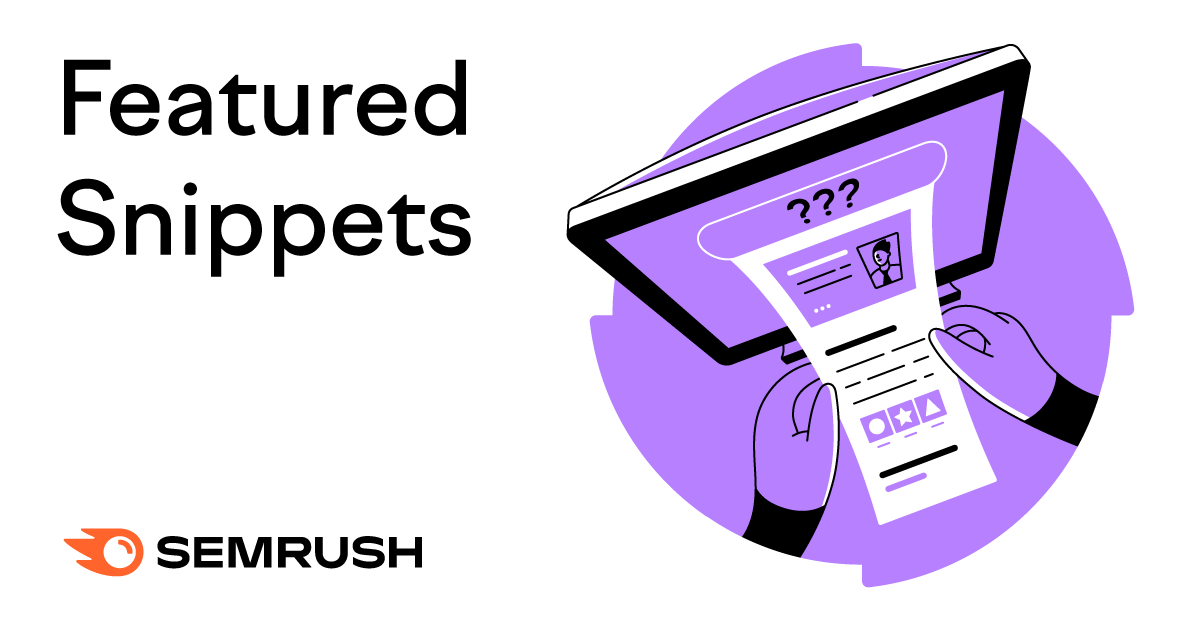If you manage marketing for a small business, you know that optimizing your material to attract traffic to your website can be a battle.
Without a strategy, it can be difficult for even the best content to rank at the top of a SERP. Fortunately, there are a few ways you can increase your chances of getting noticed.
Some of the best ways for getting eyes on your content are featured snippets. Google displays featured snippets to answer user questions quickly and directly. They show up before the top organic search results for a keyword on a SERP. If you can earn them, these snippets can help you draw traffic and expand your reach.
There are four types of featured snippets: paragraphs, tables, lists, and videos. Each can be valuable for growing search volume to your website.
In this simple guide, we’ll go over what featured snippets are, why they’re so effective for building traffic, and how you can design your content to give yourself the best chance of attaining them.
What Is a Featured Snippet?
A featured snippet is a small excerpt of content that appears at the top of an organic Google SERP. It provides a quick resource for users and shows up before the first result for a user’s query — often referred to as “Position #0.”
It’s meant to be a short, quick answer for a user’s query. Google doesn’t create content for featured snippets. Rather, it pulls content directly from a webpage found in its index.
Below is an example of the featured snippet that pops up for the Google query “how to start a business:”
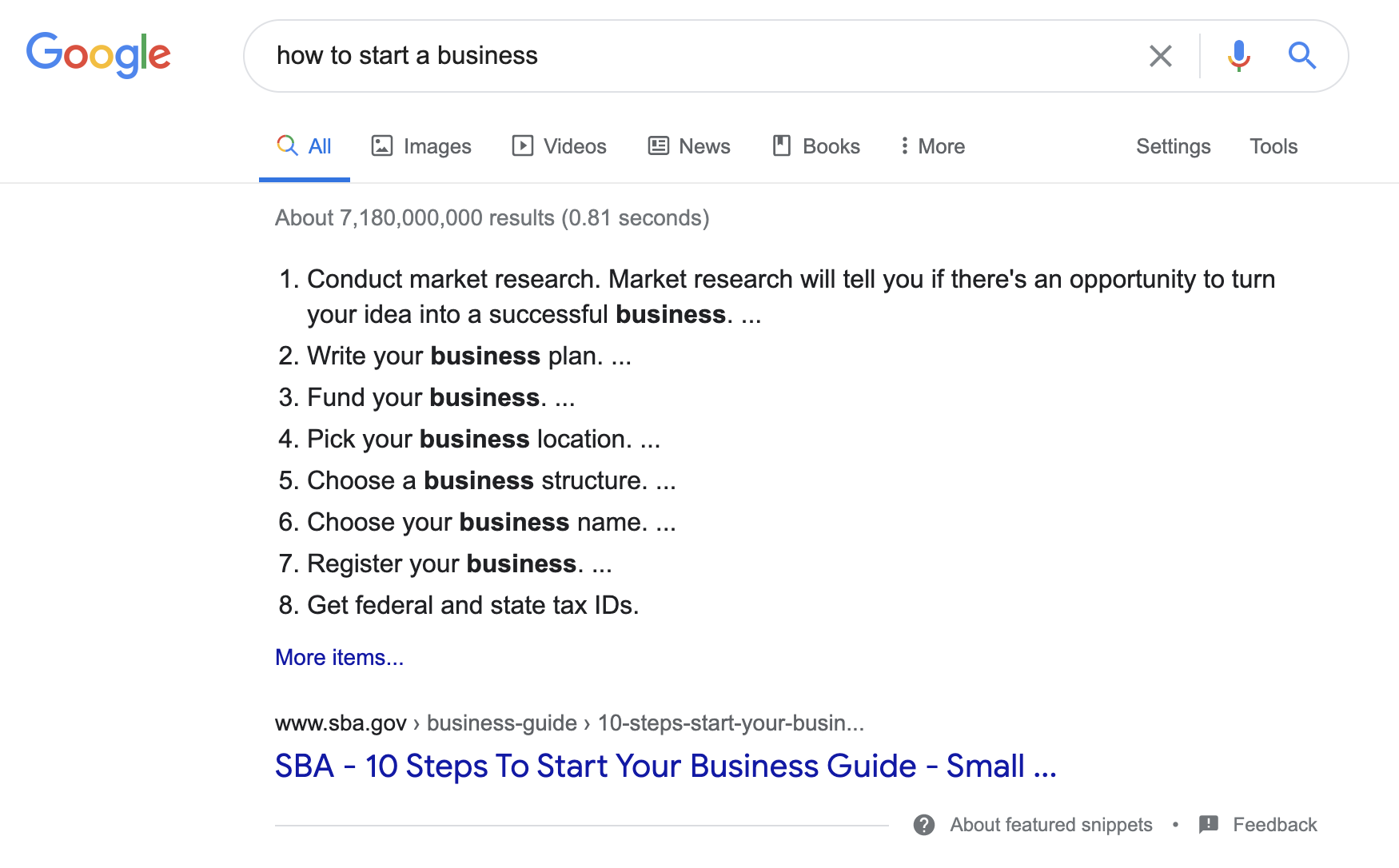
Google analyzes the query, attempts to tie its results to the user intent, and picks the best excerpt it can scrape from existing content to improve user experience.
That means “Position #0” is up for grabs. But why would you want your content to show up at the top of Google?
Featured snippets contain a link to the website they come from, and they generally (depending on the content and variety of other factors) increase the traffic to your website.
They work just as well for local websites those with a wider reach, which is worth bearing in mind if you are optimizing for snippets yourself, or using local SEO services.
Why Are Featured Snippets Important?
A snippet box makes a Google searcher’s life easier by providing a concise answer for their query. The idea is that users can skim the snippet to get a basic answer to their question without digging through a bunch of websites on the SERPs.
Featured snippet spots are important to you as a marketer because they grab a reader’s attention and increase the odds that they’ll visit your website. They’re the first thing a user sees when they perform a search. Here are a few benefits that featured snippets can have for your website:
-
Improves click-through rate (CTR): While the snippet gives users a simple answer for their query, they might be looking for more in-depth information. They can easily find what they’re looking for by clicking your featured link.
-
Increases your credibility: Featured snippets present your business as an authority on a subject. They make users much more likely to accept you as a thought leader in your field.
-
Helps you capitalize on voice technology: Virtual assistants like Alexa, Siri, Google Assistant, and Microsoft Cortana typically use featured snippets to answer their users’ vocal search queries. Over 40% of internet users perform voice searches every day on computers and mobile devices.
-
Indicates your content is effective, useful, and arranged well: Featured snippets help you evaluate your material. If Google chooses your website to be part of a snippet, it’s a good sign that content is valuable to readers.
-
Helps you weed out users not looking to buy: Featured snippets increase “no-click searches” (searches when a user doesn’t click any results) because users already find what they’re looking for. This means that if a user clicks on your link (for something like product information), there’s a higher chance they’re looking to make a purchase.
Different Types of Featured Snippets
Featured snippets aren’t one size fits all. There are a few types that Google and other major search engines use, depending on the type of information a user is searching for.
Understanding which type of snippet best fits your topic will help you organize your content and give it the best chance of being part of a featured snippet. Over the next few sections, we’ll go over a few types of featured snippets and explain how Google uses them to present information.
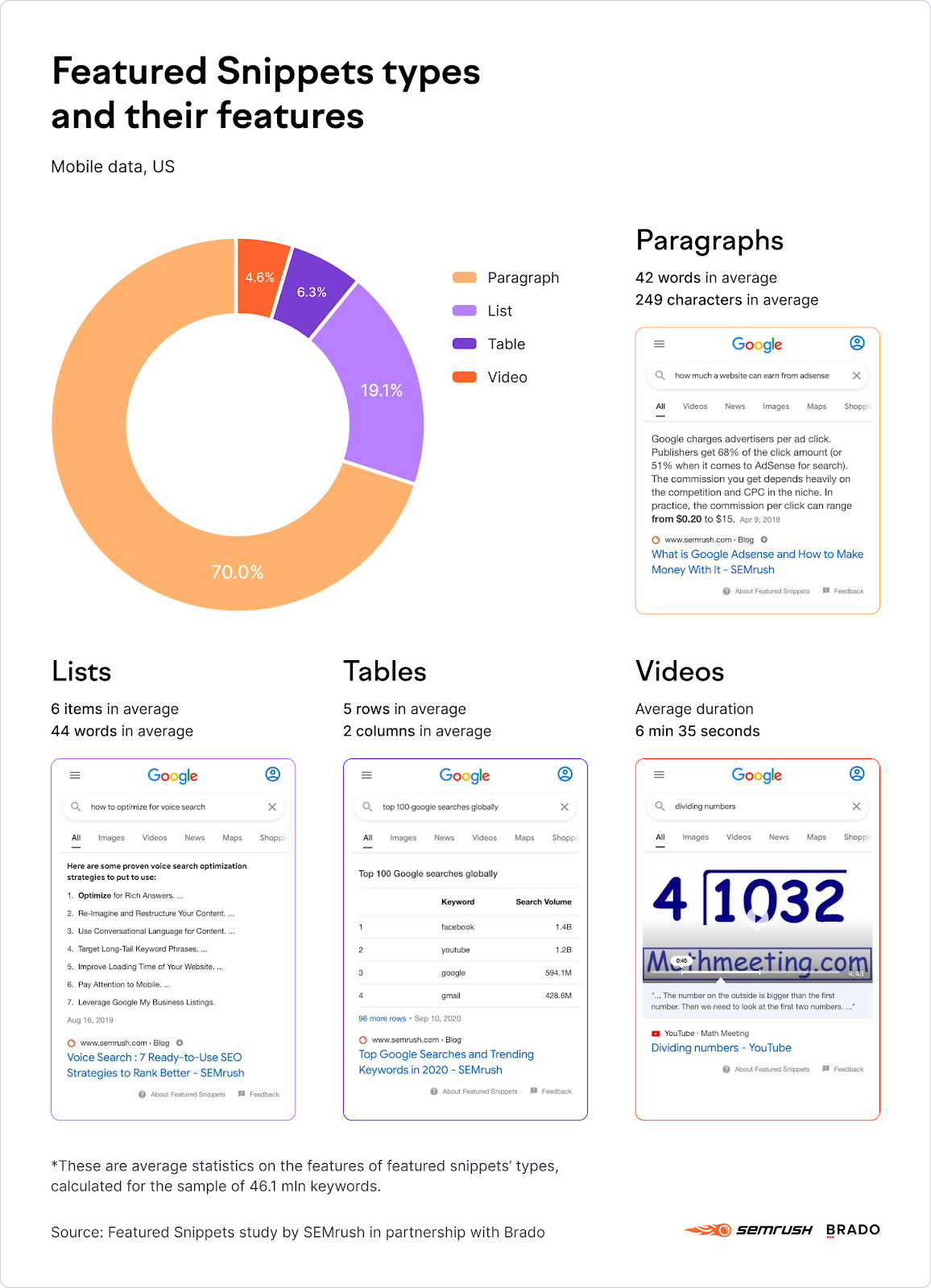
Paragraphs – Definitions, Answers, and More
This snippet provides users with a brief, practical definition or a brief bit of information on a topic.
Certain queries revolve around questions or seeking additional information. Here’s an example of a paragraph featured snippet that’s an answer box:
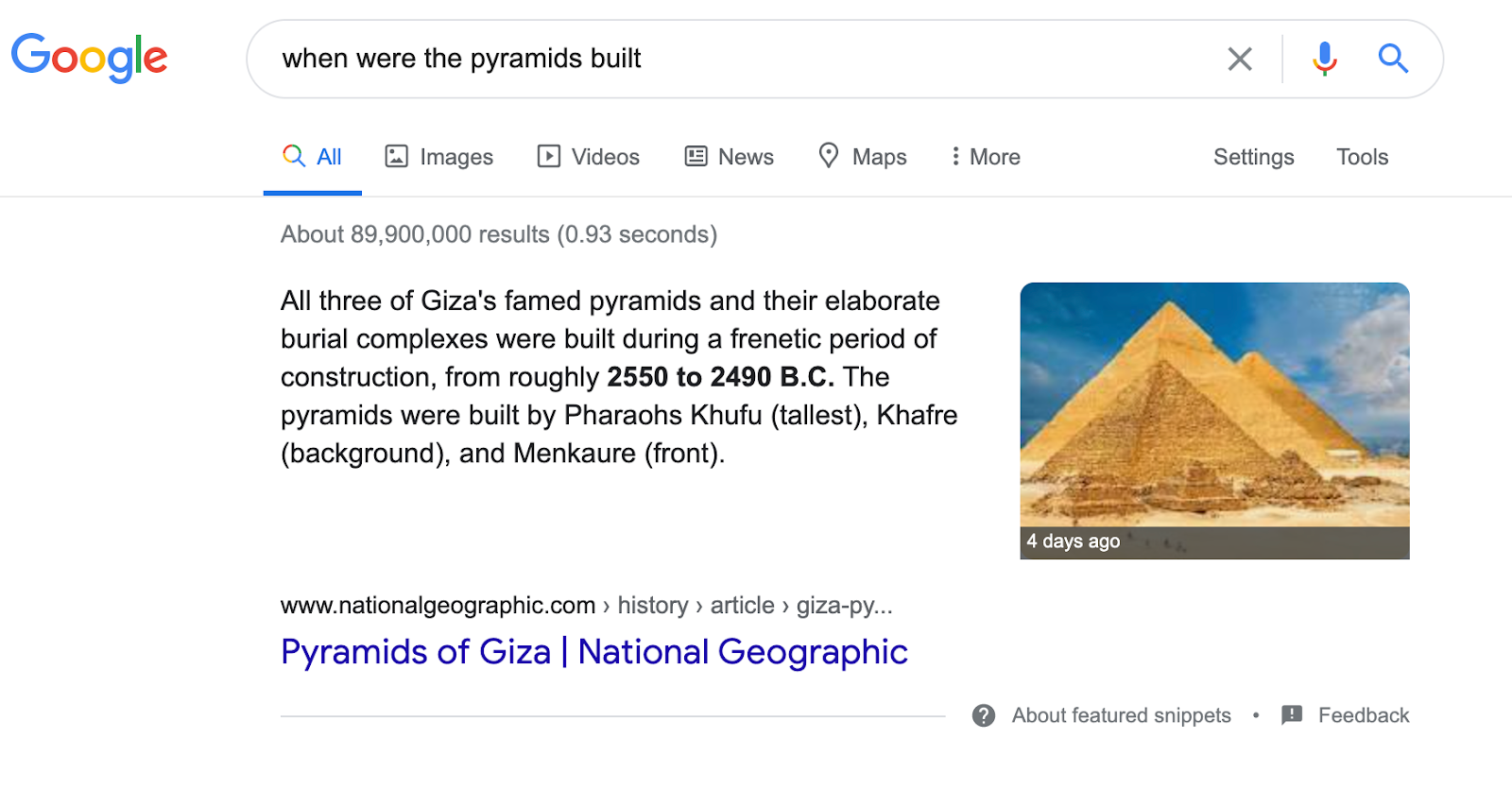
There are also definition boxes. These are for straightforward queries, where users are searching for the basic meaning of a word or concept:
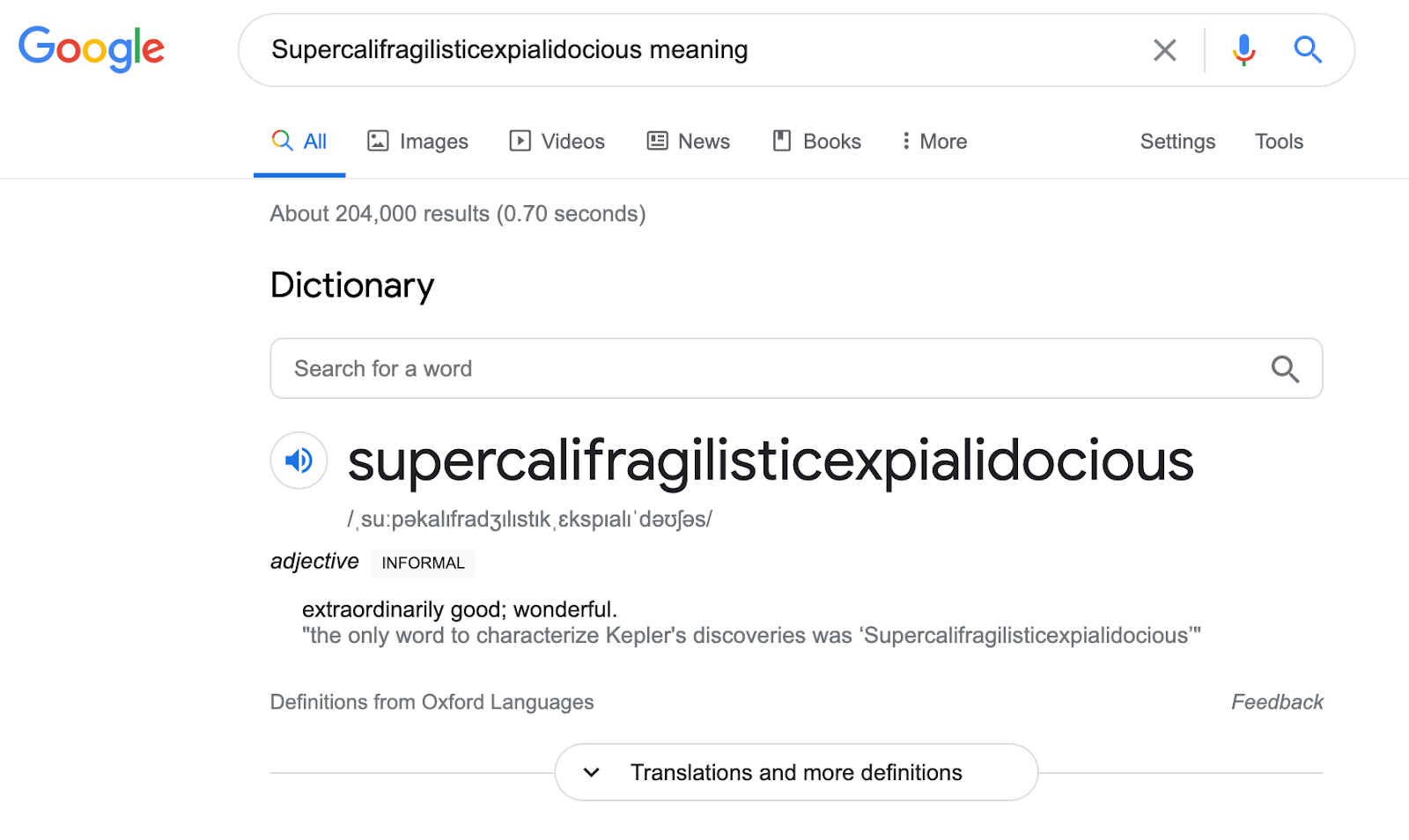
Table
This type of snippet helps users visualize data for different types of comparisons. A large percentage of Google’s featured snippets are tables.
Here’s an example of a table featured snippet for the query “earnings for biggest tech corporations in the United States 2020:”

Lists
Lists can be used to rank things, show the steps of a process, or identify different products. List featured snippets can be ordered or unordered, and you’ll see bulleted lists for both ranked and unranked items, features, and “best of” types of lists.
Here’s an example of a featured snippet with an unordered list that shows a list of different types of sports:
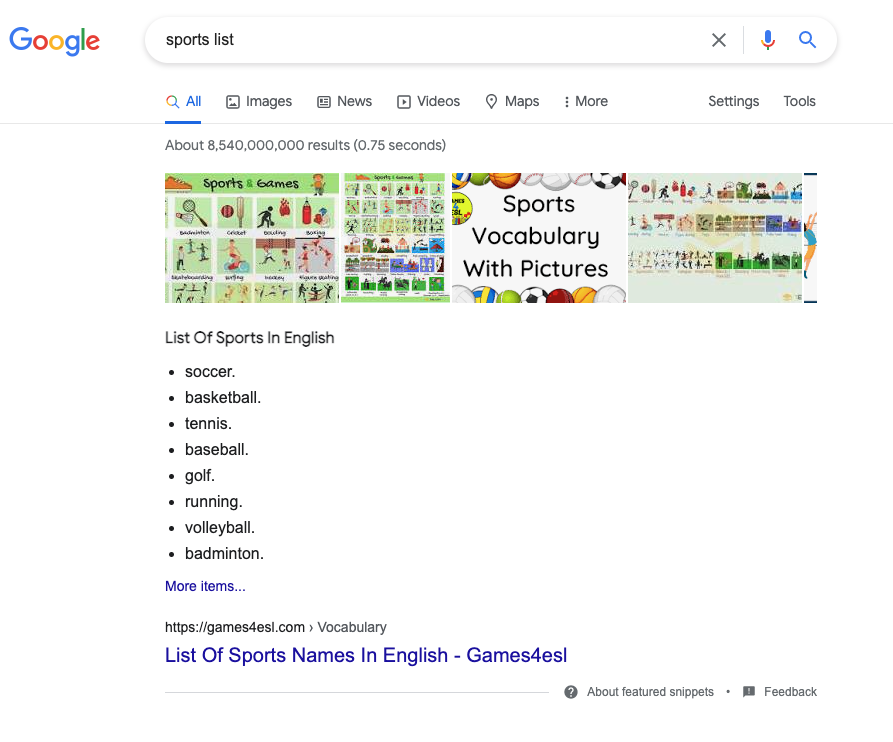
Videos
YouTube is one of the largest search engines in the world, so it’s no wonder that video featured snippets are something else you’d want to try and rank for.
If a video provides the best answer for a user’s query, it will include the video in a featured snippet. Video featured snippets can be useful for “how-to” queries.
Here’s a video snippet for the user search “how to braid hair:”
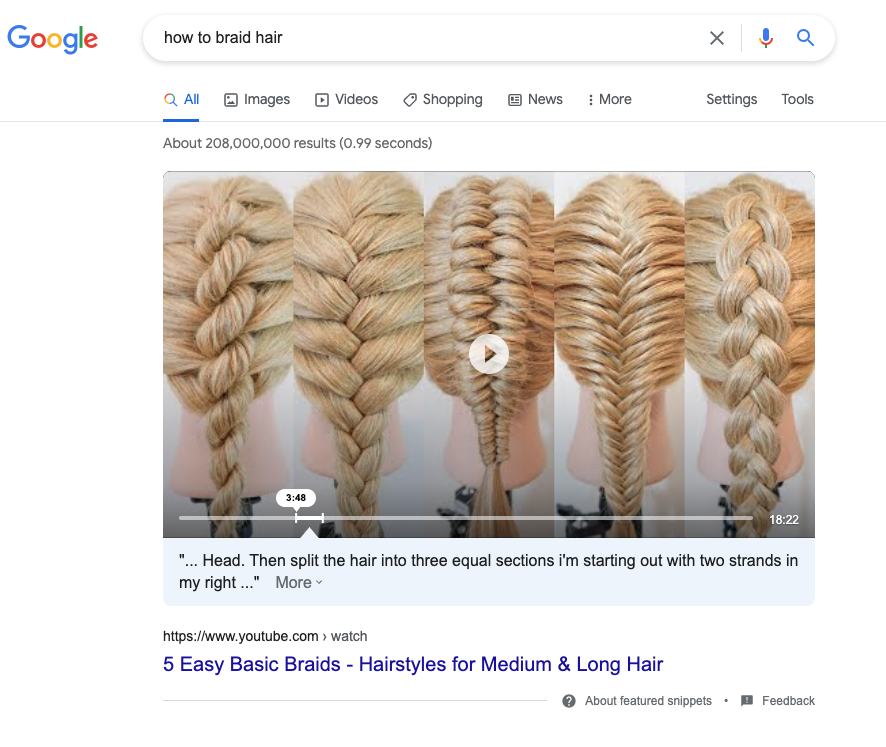
How Do I Get My Content to Rank for a Featured Snippet?
Now that we’ve gone over the basic types of featured snippets, let’s talk about how you can rank for them.
Unfortunately, there’s no way to guarantee that Google will use your content as a featured snippet. Google has algorithms that consistently evaluate snippets (and search rankings) to see which provide the best responses to certain user queries. What may have been answered in a list may end up being replaced by a video, depending on any algorithmic changes that impact the SERP.
However, what you can do is create high-quality, targeted content that has a high chance of being chosen. In the next few sections, we’ll run through some ways you can give yourself an advantage over your competition.
Use Keyword Research to Find SERPs With Featured Snippets
Effective keyword research is crucial for any SEO strategy. It can help you figure out what type of content you should make to get noticed. In the case of featured snippets, it can also help you identify specific queries that already rank for “Position #0” so that you can go after them.
There are a few ways to find the right keywords for featured snippets. The first is to manually type in queries and see what the results look like. You may have ideas for keywords for your business or site, so feel free to type them into the search bar and see what comes up.
For example, let’s say you run a website that features workouts. You can start searching for terms that make sense for your website, like “how to start a workout routine” or “at-home workouts.”
You might notice, though, that both queries don’t return a featured snippet until you cut it down to something specific like “new abs workout routine for beginners.”
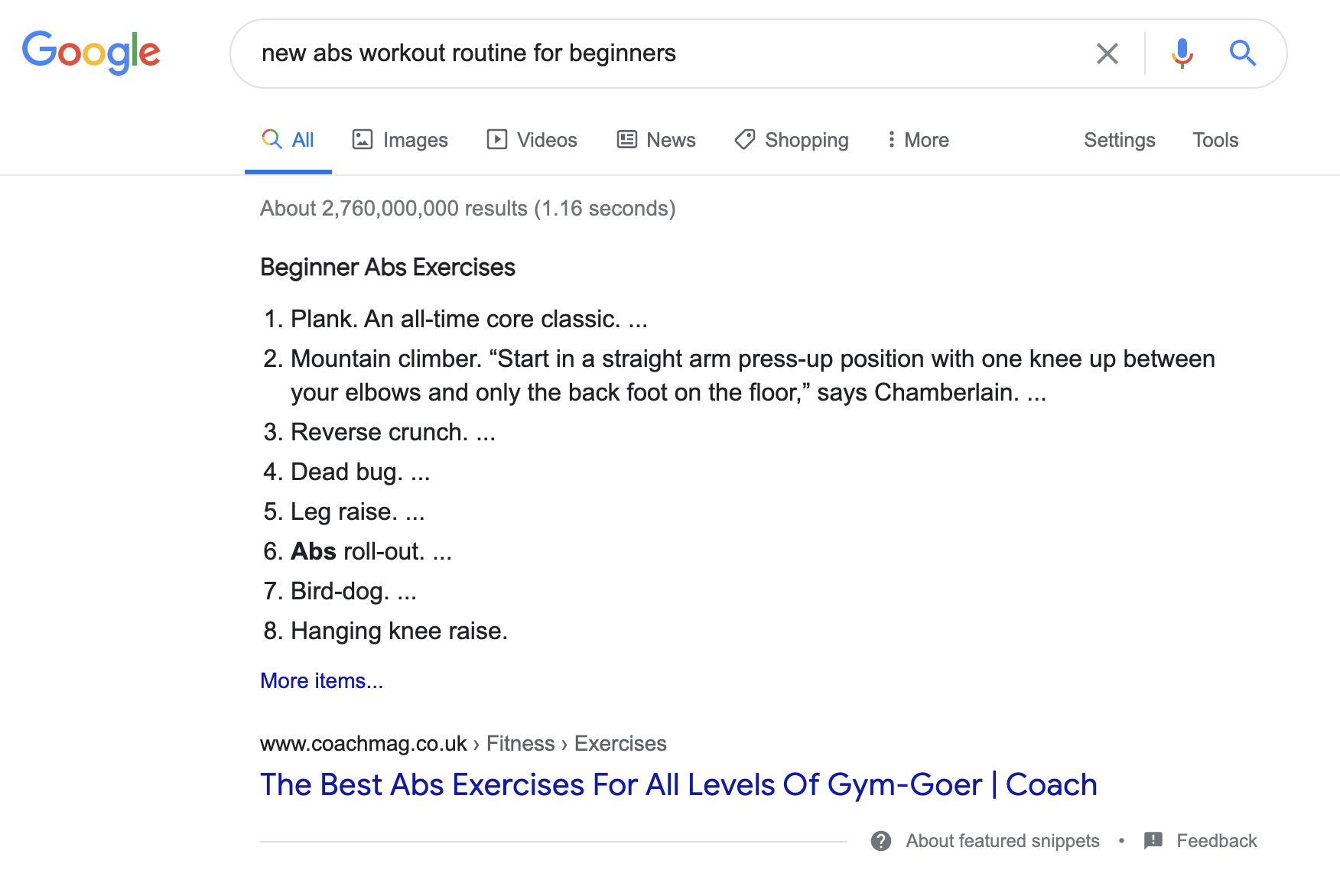
Clearly, it would take way too much time to find the right keywords you’re hoping to rank for, so how can you speed up the process? You’ll want to invest in a comprehensive keyword research tool.
Our Keyword Overview tool makes keyword research straightforward and simple. We can help you evaluate several SERP characteristics to see what topics have featured snippets, what long-tail keywords have the lowest competition, and what type of snippets rank for certain queries.
Following the example above, the keyword “workouts” reveals that particular SERP features include image packs and video carousels. When it comes to what kind of content to produce to rank for featured snippets, it will make sense to include images and videos when appropriate.

Using our Keyword Magic Tool, you can also quickly spot related queries to your target keyword that rank for featured snippets. Using the same example, you’ll notice that “shoulder workouts,” “back workouts,” and “arm workouts” all rank for a featured snippet are marked with a crown symbol under the “SERP features” column.
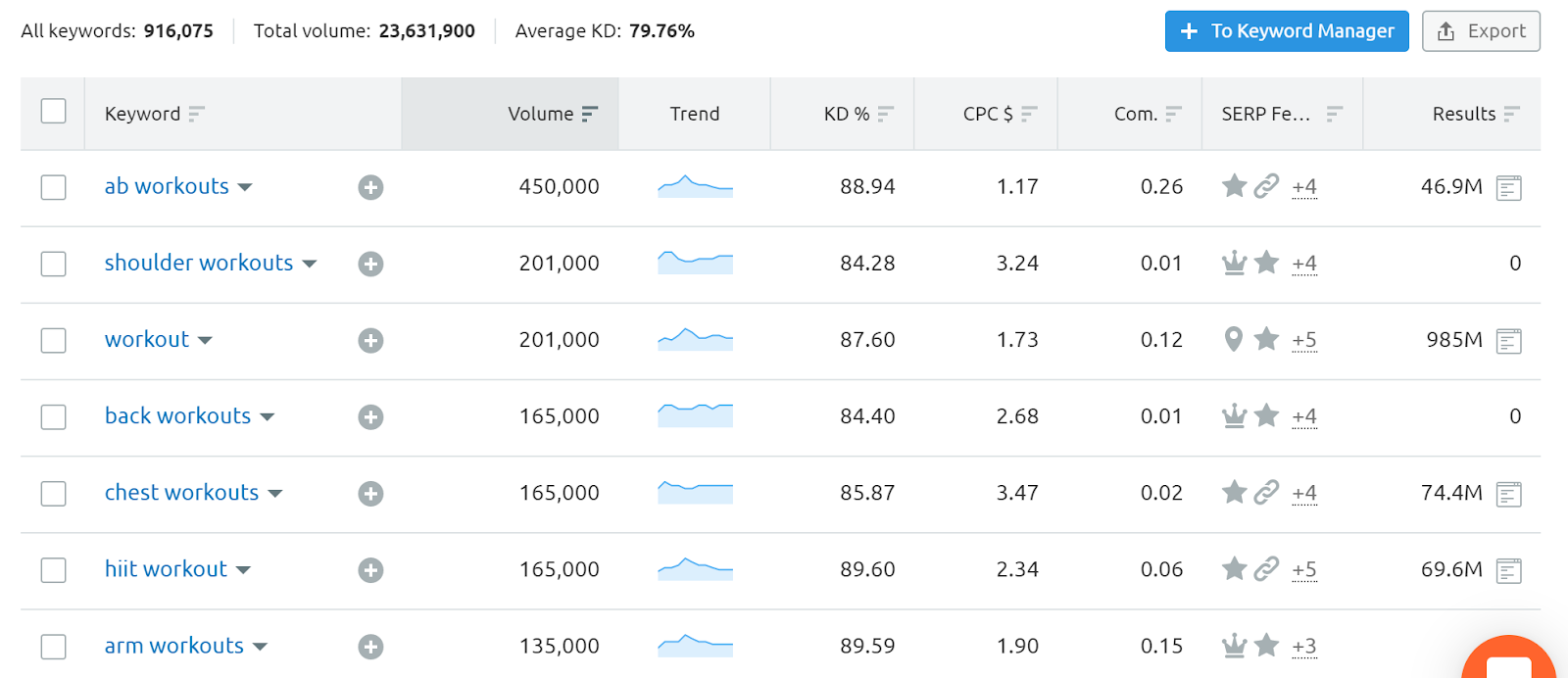
Keyword research will also help you target other information related to keywords. You can check out features like people also ask (PAA), top stories, and knowledge panels (information panels that come up to the right of a Google search) to see what questions people search for related to a topic and helpful information.
Once you determine which keywords you want to focus on for featured snippets and have created content around those terms, you can use Position Tracking to monitor your performance.
Our Position Tracking Tool monitors your website’s daily rankings for your own preferred target keywords. It can be set up to monitor featured snippets, and alert you to opportunities or changes on SERPs. Here’s what the Featured Snippet report in our tool looks like:

Write Clear, Concise, and Objective Content
While there might be several types of featured snippets, one thing they all have in common is that they’re fact-based. There’s plenty of platforms online for you to share your opinions, but Google wants content to be completely objective when it comes to featured snippets.
Your content should also be concise and to the point. A good snippet should be easy to read and understand quickly. If your goal is to attain featured snippets, keep your content as simple as possible. Big words and confusing speech only hurt your chances.
Our recent featured snippet study (which we partnered with Brado to complete) came up with some data after analyzing 46.1 million keywords on mobile and 160 million keywords on desktop in the U.S.:

Add Structured Data to Your Page
Structured data helps large search engines, like Google, Yahoo, and Bing, recognize your content and create rich snippets about it. If you add structured data to your content, it improves your SERP appearance and can even improve your chances of securing a featured snippet. Some examples of rich snippets include:
-
Reviews
-
Recipes
-
Movies
-
Events
Let’s say you’ve written an article with a buffalo chicken dip recipe. You’ve included specific information in your content, like which how much chicken is needed, how much buffalo sauce is needed, what other ingredients are required, and the cooking time.
The search engine has a better chance of identifying and featuring this specific information in your snippet if you include structured data.
You’ll want to use it in conjunction with a universal search language like the one featured on Schema.org to ensure the right content from your page gets pulled for a rich result or featured snippet. Check out our guide on rich snippets to learn more about them.
Use Effective Headings and Subheadings
One way to improve your chances of earning featured snippets is organizing and formatting your content efficiently. All your headers and subheaders should make sense in relation to each other and set up your content in a way where it can provide direct answers.
For example, let’s say you’re writing content on how to improve your core strength. Your main heading could be something like, “Build Better Abs in 30 Days,” and your subheadings could introduce the different exercises you’ll explain, like:
- Crunches
- Leg lifts
- Side raises
- Planks
Making your content easy to read is important too. Vary your sentence and paragraph length to make your content more attractive to readers.
Use bullet points and lists to improve its flow and clarity. No one wants to drudge through a jumbled, confusing article. Make it as easy as possible for readers to find the answers they’re searching for in your content.
Our SEO Content Template is a great resource to ensure your content is optimized well.
Add the query you’re trying to rank for, and you’ll find related keywords to include in your piece, its ideal length, and appropriate headers based on the top 10 competing pages in Google.

Get More Clicks as a Featured Snippet
The right featured snippets can drastically improve your website’s CTR, but they can be difficult to secure if you’re not using the right SEO tools. It doesn’t hurt to try and get featured snippets because the same practices that help you get them, like doing keyword research and organizing your content, also help keep you on the first page of Google.
Learning a few tricks and skills for building your reach can really help your business grow. Remember that building organic traffic takes time, but if you consistently make and execute plans to increase your influence, you’ll give your business the best chance of success.
Semrush has tools for keyword research that can make planning a piece of content a lot less complicated. Our in-depth data will help you find the right keywords and information to give you a leg up over the competition.

